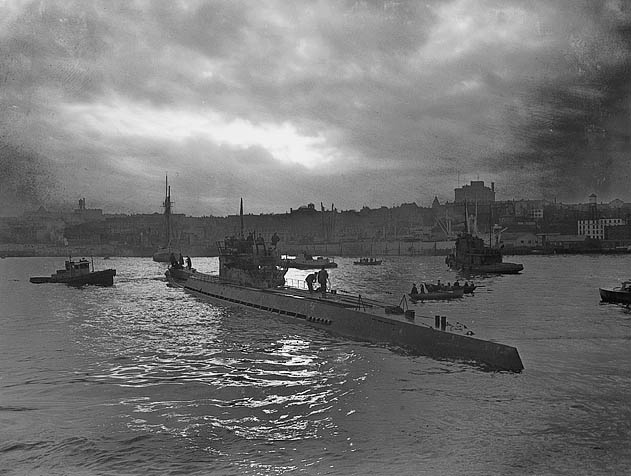
After surrendering, German submarine U-190 arrives at St. John’s in June 1945. [Wikimedia]
The Allies knew the strategic significance of Canada’s East Coast and the waters around Newfoundland, through which hundreds of convoys sailed to Britain and Russia carrying troops and millions of tonnes of food, war materiel and raw material.
The British colony provided a home for some of the warships and aircraft that defended the convoys. By the end of the war, Newfoundland counted among its defences two naval bases, five airfields, a couple of seaplane bases and five army bases.
Even before the war, the Germans had attempted to get a foothold at the mouth of the St. Lawrence River by buying Anticosti Island (Military Milestones, July 29, 2020). Their plans were foiled, but they set up a weather station on the coast of Labrador in 1943 that was not discovered until decades after the war.
Wolf packs regularly patrolled the East Coast and made forays into the Saint Lawrence, picking off ships whenever they could.
Aircraft from bases at Stephenville, Gander, Argentia, and Torbay, just outside St. John’s, protected convoys as far east as the Grand Banks, a popular hunting ground for wolf packs. Regular anti-submarine patrols were also staged from those bases.
On March 1, 1942, U.S. navy pilot Ensign William Tepuni destroyed U-656 just 40 kilometres south of Trepassey, which sits in a bay near the island’s southeastern tip.
It was the first sub sinking attributed to U.S. forces in the Second World War. Newspapers reported the pilot sent the radio signal “Sighted sub, sank same.” The report was erroneous, but nonetheless a morale booster in the U.S.
Luckily the harbour was protected by boom defences and anti-torpedo nets.
Two days later, St. John’s itself came under attack.
Kapitänleutnant Ulrich Borcherdt commanded U-587 since it was commissioned in 1941. It had sunk four merchant ships and one warship in the Atlantic south and east of Newfoundland.
In March 1942, Borcherdt set his sights on the port of St. John’s. Luckily the harbour was protected by boom defences and anti-torpedo nets. Unable to enter, he fired torpedoes that struck on the north and south sides of the harbour entrance.
The incident was kept from the public. Many residents dismissed explosions as the sound of training or test-firing of guns protecting the harbour.
But military authorities took heed, believing an attack on Newfoundland was likely, a fear confirmed in 1944 in evidence at a U.S. congressional hearing which suggested invading Newfoundland was part of Hitler’s plan to attack the United States.
“As a precaution, the Newfoundland Government asked the occupying forces to develop Scorched Earth plans for the various military facilities in case the Germans did invade,” wrote Paul W. Collins in The Battle for Bell Island. Those plans were not revealed until 1998.
Bell Island in Conception Bay came under attack in the fall when four ore boats were sunk before the Battle of the St. Lawrence drew to a close.
Although U-boat attacks on shipping continued to the end of the war, ship defences in 1943 turned the tide to favour the Allies in the Battle of the Atlantic, foiling whatever plans the Germans may have had for invading Newfoundland
Advertisement


















